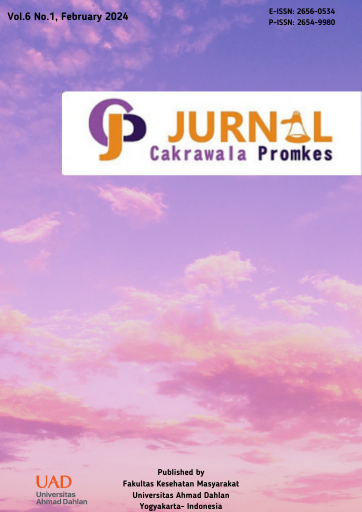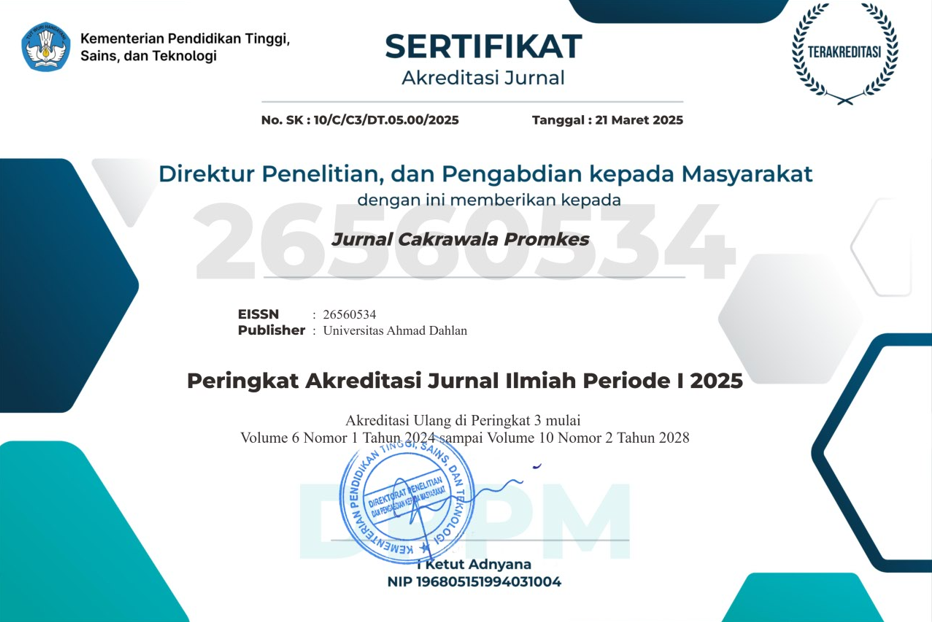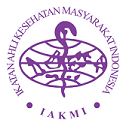Description of non-communicable diseases and risk factors related to lifestyle among POSBINDU (Integrated Guidance Posts) participants in Yogyakarta in 2022
DOI:
https://doi.org/10.12928/jcp.v6i1.8740Keywords:
Health status , Non-Communicabel Diseases, Posbindu, Risk factorAbstract
Non-communicable diseases are a public health problem and are a significant cause of death both in Indonesia and worldwide. These diseases cause a complication if not appropriately managed. Indonesian basic health research (Riskesdas) 2018 found that there was an increase in cases of non-communicable diseases compared to the previous research. One of the strategies used to control non-communicable diseases is by early detection of risk factors for non-communicable diseases through Posbindu activities. This research aims to describe the health status of participants of one Posbindu in 2022. This descriptive research uses secondary data from the results of examinations in 2022. The number of participants was 1,090 people consisting of 42.11% men and 57.89% women. The age range of the participants was 26-35 years with as many as 33.67%. Participants' highest education was undergraduate with as many as 50.09% and those with married status were 73.58%. Based on the Posbindu examination results, 578 people (53.03%) had central obesity, with 332 cases among female participants (57.44%). Posbindu participants with hypertension were 182 people where 119 of them were male (65.38%). Posbindu participants with diabetes mellitus were 30 people (2.75%), with the most cases in men, 21 (70%). Non-communicable diseases can affect anyone; the older you are, the more at risk you will get. One way to prevent non-communicable diseases is to control the risk factors such as smoking, lack of physical activity, excessive consumption of sugar and salt, and less consumption of vegetables and fruit. In the coming years, it is anticipated that further exploration will be undertaken, utilizing firsthand data collection methods, presenting findings descriptively, and employing inferential analysis techniques to draw meaningful conclusions.
References
Buys B, Buys W, Archer RA,Teerawattananon Y, Culyer AJ. Non-communicable disease prevention. Wanrudee Isaranuwatchai, Rachel A. Archer YT and AJC, editors. Geneva: https://www.openbookpublishers.com ©; 2019.
Ministry of Health of the Republic of Indonesia. Handbook for management of non-communicable diseases. Jakarta; 2020.
RI Balitbangkes. 2018 National riskesdas report.pdf. Soft. Balitbangkes Publisher. 2018. p. pg 156.
Indonesian Ministry of Health. Main results of 2018 riskesdas DIY Province. 2018;
BP Statistics. Prevalence of obesity in population aged > 18 years according to gender 2013-2018.
Indonesian KKR.Technical instructions for integrated development posts for cadres. Jakarta; 2019.
Kuruvilla A, Mishra S, Ghosh K. Prevalence and risk factors associated with non-communicable diseases among employees in a university setting: A cross-sectional study. 2023;21.
Khademi N,Babanejad M, Asadmobini A, Karim H. The association of age and gender with risk factors of noncommunicable diseases among employees in West of Iran. 2020;
Bogale KA,Zewale TA. Determinant factors of overweight/obesity among federal ministry civil servants in Addis Ababa, Ethiopia : a call for sector ‑ wise occupational health program. BMC Res Notes. 2019;1–6.
Indonesian Ministry of Health. Posbindu cadre smart book. Jakarta; 2019.
Arifani S, Setiyaningrum Z, Nutrition I, Health FI, Surakarta UM. Risk behavior factors associated with the incident of obesity in adults in Banten Province in 2018. 2021;14.
Ivan, Wijaya D. The relationship between lifestyle and diet on the incidence of hypertension in the Towata Health Center working area, Takalar district. 2020;3.
Saqib,Zulkaif, Dai J. Physical activity is a medicine for non-communicable diseases: a survey study regarding the perception of physical activity impact on health wellbeing. 2020;2949–62.
Gupta R Das, Haider SS, Hashan MR, Hasan M, Sutradhar I, Sajal IH, et al. Association between the frequency of television watching and overweight and obesity among women of reproductive age in Nepal: analysis of data from the Nepal demographic and health survey 2016.PLOS One. 2020;15:1–13.
Hermawan D, Wahyudi T,Djamaludin D. The influence of lifestyle on the incidence of diabetes mellitus in the productive age in the working area of the Gading Rejo Health Center, Pringsewu Regency, 2019. J World Health. 2021;10:145–57.
Biomedika J, Zulkarnain A, Behind L. The relationship between exercise and smoking habits and abdominal obesity in productive age employees. 2020;3:21–7.
Koryaningsih A. The relationship between energy intake and physical activity and obesity in female workers. J Ilm Nutrition and Health (JIGK. 2019;1:11–8.
K's Health Guidelines for managing obesity prevention for health workers in First Level Health Facilities (FKTP). Jakarta; 2021.
Pakaya R, Badu FD, Maliki LI. The relationship of physical activity and consumption patterns. 2020;1:68–74. Indonesian Sports & Health Journal available online at https://jurnal.stokbinaguna.ac.id/index.php/jok
Ministry of Health Republic of Indonesia. Regulation of the Minister of Health of the Republic of Indonesia Number 30 of 2013 concerning the inclusion of information on sugar, salt and fat content and health messages for processed food and ready-to-eat food. Ministry of Health of the Republic of Indonesia. 2013;1–8.
Demilew YM, Firew BS. Factors associated with noncommunicable disease among adults in Mecha district, Ethiopia: A case control study. PLOS One. 2019;14:1–13.
Downloads
Published
Issue
Section
License
Copyright (c) 2024 Ami Poniasih, Sunarti Sunarti, Sulistyawati Sulistyawati, Rokhmayanti Rokhmayanti

This work is licensed under a Creative Commons Attribution-ShareAlike 4.0 International License.
Authors who publish with JCP: Jurnal Cakrawala Promkes agree to the following terms:
- Authors retain copyright and grant the journal the right of first publication with the work simultaneously licensed under a Creative Commons Attribution License (CC BY-SA 4.0) that allows others to share the work with an acknowledgement of the work's authorship and initial publication in this journal.
- Authors are able to enter into separate, additional contractual arrangements for the non-exclusive distribution of the journal's published version of the work (e.g., post it to an institutional repository or publish it in a book), with an acknowledgement of its initial publication in this journal.
- Authors are permitted and encouraged to post their work online (e.g., in institutional repositories or on their website) prior to and during the submission process, as it can lead to productive exchanges, as well as earlier and greater citation of published work.

This work is licensed under a Creative Commons Attribution-ShareAlike 4.0 International License












